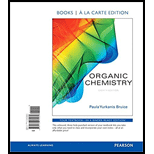
(a)
Interpretation:
Change in
Concept introduction:
Gibbs free energy change
Gibbs free energy change
Equilibrium constant: The relative concentration of reactants and products at equilibrium can be expressed by equilibrium constant.
For a general reaction
Gibbs free energy change: The difference between the free energy of the products and the free energy of reactants under standard conditions is called Gibbs free energy change.
(b)
Interpretation:
The variation of
Concept introduction:
Gibbs free energy change
Gibbs free energy change
(c)
Interpretation:
The variation of
Concept introduction:
Gibbs free energy change
Gibbs free energy change
Want to see the full answer?
Check out a sample textbook solution
Chapter 5 Solutions
ORGANIC CHEMISTRY (LL)-W/MOD.MASTERING.
- 10.46 Discuss the effect of temperature change on the spontaneity of the following reactions at 1 atm. (a) Al2O3(s)+2Fe(s)2Al(s)+Fe2O3(s) H = 851.5kJ; S =38.5 J/K (b) N2H4(l)N2(g)+2H2(g) H =-50.6 kJ; S= 0.3315 kJ/K (c) SO3(g)SO2(g)+12O2(g) H = 98.9 kJ; S= 0.0939 kJ/Karrow_forwardWhat is Δ G° at 25 °C? N 2O 4(g) → 2 NO 2(g) Δ H° = 58.03 kJ Δ S° = 176.7 J/K 62.45 kJ 58.21 kJ 5.37 kJ 53.6 kJ 111 kJarrow_forward10. What is the ΔH of the reaction 2KS+2K→2K2S?K+S→KS ΔH=+32.5 kJKS+K→K2S ΔH=+38.2 kJ A +70.7 kJ B +65 kJ C +6 kJ D +76.4 kJarrow_forward
- For which reaction will ΔS be positive? Group of answer choices N2O4(g) ⟶ 2 NO2(g) 2 H2(g) + O2(g) ⟶2 H2O(g) 3 NO(g) ⟶NO2(g) + N2O(g) 2 SO2(g) + O2(g) ⟶2 SO3(g)arrow_forwardCalculate ΔG°rxn, ΔH°rxn, and ΔS°rxn of the following reaction: 2O3(g) -> 3O2(g)arrow_forwardConsider the reversible reaction: 2 HBr(g) H2 (g) + Br2 (g) KC = 1.6 x 10-2 at a certain temperature What is the KC value of the following, at the same temperature? H2 (g) + Br2 (g) 2 HBr(g)arrow_forward
- Given the following equation, N2O(g) + NO2(g) → 3 NO(g) ΔG°rxn = -23.0 kJ Calculate ΔG°rxn for the following reaction. 3 NO(g) → N2O(g) + NO2(g) A) -23.0 kJ B) 69.0 kJ C) -69.0 kJ D) -7.67 kJ E) 23.0 kJarrow_forwardCalculate (delta)So values for the following reactions by using tabulated So values from Appendix C.(a) 2 CH4(g) C2H6(g) + H2(g)(delta)So = J/K(b) Al(s) + 3 Cl2(g) 2 AlCl3(s)(delta)So = J/K(c) 4 Al(s) + 3 O2(g) 2 Al2O3(s)(delta)So = J/K(d) 2 Fe(s) + O2(g) 2 FeO(s)(delta)So = J/Karrow_forwardPart 1. Select all points for which free energy is higher than it is at equilibrium Pts A B C D E Part 2. Select the points on the diagram for which Q>K Pts A B C D Earrow_forward
- If ΔG0 = −106 kJ/mol for this reaction at 298K, what is the Keq at this temperature? Recall: R = 8.314 J mol−1 K−1 a. 1.19 x 1020 b. 3.81 x 1018 c. 3.50 x 1014 d. 7.21 x 1012arrow_forwardWhat is the ΔH of the reaction KS→K+S?K+S→KS ΔH=+32.5 kJKS+K→K2S ΔH=+38.2 kJ A +32.5 kJ B +6 kJ C +70.7 kJ D -32.5 kJarrow_forwardWhat is the free energy change for the reaction below? 2VO2+(aq) + 4H+(aq) + Ni(s) ® 2VO2+(aq) + 2H2O(l) + Ni(s) E� = 1.23V 118.68 kJ 237.35 kJ -237.35 kJ -118.68 kJarrow_forward
 Chemistry & Chemical ReactivityChemistryISBN:9781133949640Author:John C. Kotz, Paul M. Treichel, John Townsend, David TreichelPublisher:Cengage Learning
Chemistry & Chemical ReactivityChemistryISBN:9781133949640Author:John C. Kotz, Paul M. Treichel, John Townsend, David TreichelPublisher:Cengage Learning Chemistry for Engineering StudentsChemistryISBN:9781337398909Author:Lawrence S. Brown, Tom HolmePublisher:Cengage Learning
Chemistry for Engineering StudentsChemistryISBN:9781337398909Author:Lawrence S. Brown, Tom HolmePublisher:Cengage Learning

